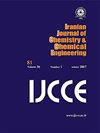聚合物、月桂皂和棕榈纤维复合在循环牛顿液体中的减阻实验研究
IF 1
4区 工程技术
Q4 CHEMISTRY, MULTIDISCIPLINARY
Iranian Journal of Chemistry & Chemical Engineering-international English Edition
Pub Date : 2021-10-27
DOI:10.30492/IJCCE.2021.134760.4280
引用次数: 0
摘要
流动性和降低压力是管道输送的一些经济价值。本文研究了由大分子量聚合物、月桂皂和枣椰树纤维组成的自制阻力系数组合在湍流水流作用下诱导进入循环管道系统的功能。实践证明,该组合公式是一种经济有效的新型减阻方法。通过几个案例研究,对聚合物、棕榈纤维和肥皂混合物的减阻效果进行了全面评估。使用纯聚电解质时,在聚合物浓度最高(50 ppm)的情况下,在低雷诺数为17166.7的情况下,在10.3 mm管径处的减阻率达到50%,在13.5 mm管径处的减阻率达到70%。当使用由(50 ppm)和(30-60 ppm)纤维组成的聚电解质混合物时,在10.3 mm管径和13.5 mm管径中,阻力分别减少了63%和76%。在测试了由聚电解质(50 ppm)和肥皂组成的混合物(50-150 ppm)后,结果表明,在低浓度肥皂和低雷诺数的散装流条件下,减阻效果最好。上述性能结果表明,在10.3 mm管径和13.5 mm管径下,阻力分别降低了70%和96%。这是通过优化所应用的混合配方来实现的。与纯聚合物相比,聚合物混合物的减阻效果更高。然而,当使用聚合物皂液时,所获得的阻力减少量略有下降,这是由于棕榈纤维的阻碍,最终减少了所有肥皂颗粒到达停滞壁层的机会本文章由计算机程序翻译,如有差异,请以英文原文为准。
An experimental investigation on drag reduction by a combination of polymer, Laurel soap and palm fiber through circulated Newtonian liquid
Flowability and reduced pressure are some of the economic values in pipeline transportation. In this study, we investigated the functionality of self-made drag coefficients composed of a combination of large molecular weight polymer, Laurel soap, and date palm fiber which were induced into a circulated piping system under turbulent water flow. The proposed combination formulas are proved to be a new cost-effective drag reduction approach. The efficiency of using a mixture of polymer, palm fiber, and soap on the drag reduction was thoroughly evaluated via investigating several case studies. Using pure polyelectrolyte showed that at the highest polymer concentration (50 ppm), the percentage of drag reduction reaches 50% in 10.3 mm pipe diameter and 70% drag reduction in 13.5 mm pipe diameter at a flow of low Reynolds number counted 17166.7. Upon applying a mixture of polyelectrolyte composed of (50 ppm) and fiber in the range (30-60 ppm), a drag reduction of 63% in 10.3 mm pipe diameter and 76% in 13.5 mm pipe diameter were achieved, respectively. Upon examining a mixture composed of polyelectrolyte (50 ppm) and soap in a range (50-150 ppm), the results showed that the highest drag reduction was achieved at a low concentration of soap and a bulk flow at a low Reynolds number. The aforementioned performance results were exemplified attaining drag reductions of 70% in 10.3 mm pipe diameter and 96% in 13.5 mm pipe diameter, respectively. This is accomplished through optimizing the applied mixture formulas. The estimated drag reductions were shown higher when applying the polymer mixture compared to that of pure polymer. However, a slight decrease in the attained drag reductions when using polymer-soap was observed and attributed to the hindrance from the palm fiber, which ultimately reduces the chance for all soap particles to reach the stagnant wall layer
求助全文
通过发布文献求助,成功后即可免费获取论文全文。
去求助
来源期刊

Iranian Journal of Chemistry & Chemical Engineering-international English Edition
CHEMISTRY, MULTIDISCIPLINARY-ENGINEERING, CHEMICAL
CiteScore
2.80
自引率
22.20%
发文量
0
审稿时长
6-12 weeks
期刊介绍:
The aim of the Iranian Journal of Chemistry and Chemical Engineering is to foster the growth of educational, scientific and Industrial Research activities among chemists and chemical engineers and to provide a medium for mutual communication and relations between Iranian academia and the industry on the one hand, and the world the scientific community on the other.
 求助内容:
求助内容: 应助结果提醒方式:
应助结果提醒方式:


